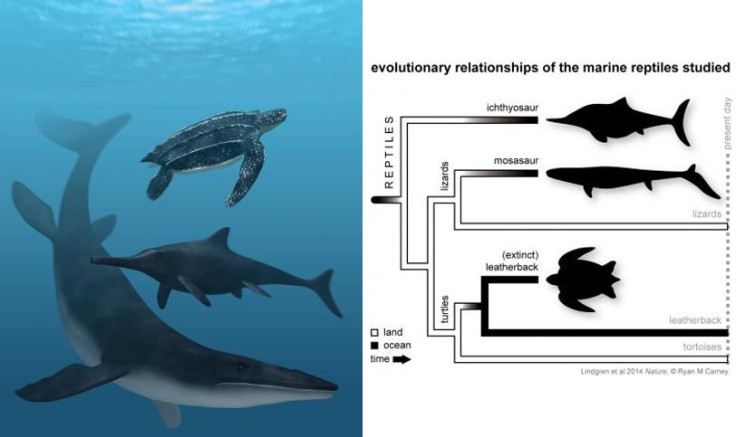Soft Pigments In Ancient Fossils Reveal Colors Of Prehistoric Sea Monsters

Scientists have found fossil pigments of reptiles that roamed the Earth millions of years ago, helping them reveal that these ancient giant creatures had dark-colored skin that provided them with protection from predators and shielded them from ultraviolet radiation.
Previously, scientists could only guess as to the skin color of these huge reptiles that lived in the age of the dinosaurs. However, the pigment preserved in the fossilized skin has now been analyzed by the scientists, allowing them for the first time to reveal the skin-color scheme of an extinct marine animal. The soft tissue remains were obtained from an 85 million-year-old mosasaur and a 196 million-year-old ichthyosaur, and a 55 million-year-old leatherback turtle, according to scientists.
“Our results really are amazing. The pigment melanin is almost unbelievably stable. Our discovery enables us to make a journey through time and to revisit these ancient reptiles using their own biomolecules,” Per Uvdal of the MAX IV Laboratory at the Lund University in Sweden and the study’s co-author, said in a statement.
According to the study, led by Johan Lindgren of Lund University, it can now be established that the prehistoric sea monsters had, at least partially, dark-colored skin, something that probably contributed to more efficient thermoregulation -- the ability to keep body temperature within certain boundaries, even when the surrounding temperature is very different. The dark skin is also believed to have acted as a camouflage to confuse predators, and as protection against harmful UV radiation.
In the study, which was published in the journal Nature, the researchers studied the chemical content of the soft tissues and were able to confirm that they were the remnants of the animals' own colors.
“Now, we can finally use sophisticated molecular and imaging techniques to learn what these animals looked like and how they lived,” Uvdal said.
Mosasaurs, which lived 98 million years ago, were giant marine lizards measuring up to 15 meters long, whereas ichthyosaurs lived about 250 million years ago and could grow to be even larger than the mosasaurs. While both ichthyosaurs and mosasaurs died out during the Cretaceous Period, leatherback turtles still exist today.
According to the researchers, a conspicuous feature of the living leatherback turtle, Dermochelys, is that it has an almost entirely black back, which probably contributes to its worldwide distribution. The black color also enables the animal to heat up faster and attain higher body temperatures.
“The fossil leatherback turtle probably had a similar color scheme and lifestyle as does Dermochelys,” Lindgren said. “Similarly, mosasaurs and ichthyosaurs, which also had worldwide distributions, may have used their darkly colored skin to heat up quickly between dives.”
The modern deep-diving sperm whale also has a similar colour scheme, perhaps as camouflage in a world without light, or as UV protection, given that they spend extended periods of time at or near the sea surface in between dives.
© Copyright IBTimes 2024. All rights reserved.












